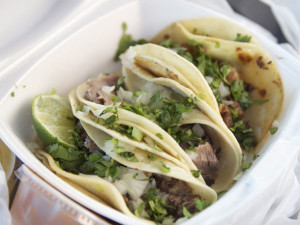In the early days of television (1954) HG and a colleague recently arrived in New York from California, wrote TV news programs that were broadcast nationally. The news was illustrated with still photos (they were called “telops”) which were transmitted by telephone wire to the TV stations (news film was introduced at a later date). HG and his pal were swift and nimble news writers and photo selectors. It was fun. International News Service, the Hearst wire service (later absorbed by United Press) was HG’s employer. INS was housed in the Daily Mirror building on E. 45th Street and HG usually lunched in the hole-in-the-wall Greek diner off the building’s lobby. But, knowing that his California buddy missed Mexican food, HG invited him to lunch at Manhattan’s only Mexican restaurant, Xochitl. A mistake. “This is a bad joke,” he declared in reference to both the food and the high price of lunch. In the 1960’s HG/BSK visited friends in California (their first trip to the state) and were determined to eat “real” Mexican food. Their friends (not foodies) took them to a nearby Taco Bell (then only in California). HG/BSK found it satisfactory but felt there was something missing. HG thought about all of this at a Sopaipilla Factory dinner last night (the eatery is in Pojoaque, New Mexico, a few minutes from HG/BSK’s home). HG/BSK and their visiting eight-year-old grandson, Haru, feasted on menudo, enchiladas, green and red chile of a quality simply unimaginable to a New Yorker of the 1960s. Not so to present-day New Yorkers like grandson Haru, who knocked off a bunch of chicken tacos declaring them to be “awesome” with the caveat that, as a Brooklyn guy who regularly dines in Sunset Park (a Mexican neighborhood near his home), he has devoured many an authentic taco. In fact New York is having such a Mexican food renaissance (with both high end and low down options) that HG’s Californian pal would probably find much to smile about. As part of this renaissance, HG is looking forward to next month’s opening of Rosie’s, Restaurateur Daughter Victoria’s next New York restaurant. This will feature farm-to-table Mexican cooking. (Husband/chef Marc Meyer has just returned from a two-week visit in Mexico with Diane Kennedy, the ultimate authority on Mexican cuisine). Meanwhile, HG will be off to nearby El Parasol to give visiting Haru another taco fix.
Viva Mexico
February 23rd, 2015 § 0 comments § permalink
The Evolution of Japanese Dining In New York
February 21st, 2015 § 3 comments § permalink
The first time HG ever dined in a Japanese restaurant was in 1958. The restaurant was Suehiro, a tiny room near Columbia University. It was one of two Japanese restaurants in New York (the other was in the East 20’s). There were no sushi or ramen eateries in this very cosmopolitan city. HG’s Suehiro meal consisted of miso soup (with some tiny cubes of tofu), beef sukiyaki cooked table side in an electric pan by a kimono clad waitperson. Sliced orange for dessert. A pot of hot green tea. The check was laughably small and the satisfaction was great. HG was hooked. Never tasted sushi until the 1960’s when the first sushi bar opened in the West 40’s. First taste didn’t impress. But, subsequent visits made HG a raw fish convert. Now, of course, New York has scores of Japanese restaurants specializing in everything from fried chicken to curry to traditional Japanese pub food. The choices for sushi and ramen are limitless — from small dive joints to $800 omakase feasts at one of the city’s most exclusive sushi emporiums. HG is bemused at the fact that Japanese restaurants now vastly outnumber Jewish delicatessens (there are less than ten) in Manhattan. HG/BSK delighted in the food they consumed in Tokyo and Osaka (HG/BSK were in Japan some ten years ago for the marriage of SJ and Exquisite Maiko). SJ and EM guided HG/BSK through the vast food markets in the two cities. There were visits to a delightful sake bar and stops for grilled chicken and pork, fried balls of chopped octopus and much more. Slurped a lot of memorable ramen. One of the benefits of having a Japanese daughter-in-law (besides her production with assistance of SJ of Haru and Teru, HG/BSK’s wonderful grandkids) is cuisine. EM is HG/BSK’s favorite cook. As HG has noted in many posts, EM produces the world’s best tempura, robust stews and soups and life enhancing seafood. Her meals at SJ/EM’s Brooklyn home or in the family Prince Edward Island ocean front paradise are among life’s most joyous occasions.
The Knish
February 12th, 2015 § 0 comments § permalink
The Knish is an Eastern European street food introduced to the United States by turn of the century Jewish immigrants from Belorussia. The Knish is a flaky pastry filled with a variety of stuffings—potato, kasha (buckwheat groats), spinach, cheese. A famous name in knishes (and loan-sharking…but that is another story) is Yonah Schimmel. Yonah began selling knishes from a pushcart on New York’s Lower East Side in 1890. The Yonah Schimmel knish bakery has been at its present location on East Houston Street since 1910. (There seems to be a spelling confusion. The big sign on the store says “Yonah Shimmel” even though the correct spelling is “Schimmel.”) Another top knish baker (alas, departed) on the Lower East Side was a woman named Gussie Schwebel who ran an eponymous knishery near Schimmel’s on Houston Street. Gussie was a flamboyant self promoter with a flair for publicity. In 1942, she wrote a letter to First Lady Eleanor Roosevelt in which she volunteered to bake knishes for our brave soldiers overseas. The suggested pastries would provide needed nourishment. She followed that up with another letter offering to deliver a sampling of hot knishes to the Roosevelt town house on E. 65th Street. Mrs. Roosevelt accepted the offer and the Jewish Daily Forward newspaper ran a front page story headlined: “Mrs. Roosevelt To Taste Jewish Knishes.” When delivery day arrived the Roosevelt home was surrounded by reporters, cameramen and a curious crowd. Canny Gussie Schwebel (or her press agent) had tipped off the newspapers. Mrs. Roosevelt, who didn’t enjoy being the target of press agentry, refused the knishes. Thus, the U.S. military had to fight World War Two without the benefit of nourishing knishes. (The information about Gussie Schwebel and Eleanor Roosevelt is from Laura Silver’s invaluable,researched book: “Knish: In Search of the Jewish Soul Food”. Published by Brandeis. The link is http.// www. knish.me).The knish, long only found in New York City, is making a modest comeback. Knish bakeries have opened in Los Angeles and a few other cities. Zabar’s (on New York’s Upper West Side) bakes knishes and sells them online. Gabila’s (located in Copiague, L.I.) is a mass producer of knishes who claim to have sold over a billion. HG has never fancied knishes. HG was spoiled by his Mom’s incomparable cheese (potato or kasha) blintzes served from a hot frying pan placed on the dining room trivet. Accompanied by a big bowl of rich sour cream. Ah!!!
The Great Italian Sausages Of New York & New Jersey
January 31st, 2015 § 0 comments § permalink
HG must make an admission: Despite the best wife in the world, glorious weather, stirring natural vistas, a beautiful home, interesting neighbors, history, art, culture and an abundance of smoky, lush green chiles HG’s life is incomplete. Why? The great New York/New Jersey Italian fennel sausage is unobtainable in the Land of Enchantment. Yes, Whole Foods, Trader Joe’s, Kaune’s and every supermarket display and purvey “Italian” sausages. “Italian” ? They are as Italian as Mitt Romney. They should be labeled “Mormon” sausages. They lack the fennel seeds and other time honored ingredients that make the New York Italian sausage so juicy, flavorful and memorable. During the opening scenes of the film, “Godfather II”, that wonderful actor/director/playwright/teacher Mike Gazzo (playing Frankie Pietangeli) laments the absence of sausage and peppers in Nevada. Frankie’s woe echoes HG’s. What HG has is memories. Sausage, peppers and onions served on good bread, dispensed from the back of a truck in Greenwich Village. The same dish bought from a cart on Lexington Avenue, eaten while racing to a business appointment. Sausage and peppers at the San Gennaro Festival in Manhattan (years ago when the the Festival was smaller and food was better) and at traditional festivals in the Mott Haven section of The Bronx. Sausage and peppers at old time, cheap restaurants in the Belmont section of The Bronx and in Little Italy (before it became a tourist travesty). There were Italian restaurants in northern New Jersey that made an epic of the dish. Jerry’s in East Rutherford (tragically, closed after many decades of operation) did it best. This is how The New York Times described it in 1998: “Jerry’s combines garlicky, crisp and juicy Chicken Scarpariello (chunks of chicken on the bone) with great fruity rounds of pepper (both hot and sweet), fried onions, crunchy Red Bliss potatoes, and plenty of Jerry’s fennel-scented sausage.” Yes, this expanded plain spoken “sausage and peppers” into a regal feast. This was an enormous platter of food. HG/BSK would dig in, drink a lot of modest Chianti and manage to finish about 60%. Appetizer? Dessert? Fuhgeddabout it !!!
Schmaltz Is Back!
January 23rd, 2015 § 1 comment § permalink
Yes, schmaltz, delectable chicken fat, is making a comeback. It’s in the news. The New York Times recently reported that restaurant chefs and knowing home cooks are using the magical ingredient to enhance a variety of dishes. While some cardiologists and health police deride the golden goodness of chicken fat others are proving that, yes indeed, Moms may have been right all along citing schmaltz’s high level of heart healthy mono-saturated fats. Well, chicken fat may not be as good for the body as kale, but it provides real solace for the soul. HG’s favorite after school snack was a slice of Stuhmer’s pumpernickel bread covered with a good quarter-inch of chicken fat, kosher salt and black pepper. (Sometimes, HG’s thoughtful Mom added a slice of raw onion). Thus fortified, little HG was ready for competitive street games of punchball and “association” football. (The street was a playground in the 30’s and wartime 40’s since automobiles were scarce). HG’s Dad’s favorite use of chicken fat was in the form of “grieven” (or “gribenehs”). These were crisp, salty, lush bits of rendered chicken skin. The late, beloved Hershele Zvi Freimann would accompany this treat with a slice of rye bread and a modest tumbler of Park & Tilford rye whiskey. HG has a fond memory of HG’s Mom’s chopped hard boiled eggs and onions mixed with plenty of schmaltz. Her “latkes” (potato pancakes) fried in chicken fat were superior. There was plenty of chicken fat in her chopped liver. This was accompanied by slices of pungent black radish, also liberally gilded with schmaltz. The Temple of Schmaltz is Sammy’s Romanian Restaurant on New York’s Lower East Side. There’s a pitcher of schmaltz on every table. There’s also a bottle of vodka encased in ice. So, be assured, a raucous, inebriated, nostalgic good time is to be had. A schmaltzy joint, indeed.
Waitpersons
January 20th, 2015 § 2 comments § permalink
Okay. Now that we strive for political correctness, there are only “waitpersons.” Farewell to “waiters” and “waitresses.” On the not-so-politically-correct side, HG has noticed that “waitpersons” in all cheap but delicious Chinese restaurants are unsmiling and peremptory. On the other hand, Latino “waitpersons” in New Mexico, whether serving in a white tablecloth restaurant or a rough hewn roadside truck, are gracious, smiling and efficient. Joyous welcoming shouts and farewells are traditional in Japanese businesses, restaurants included. Paris “waitpersons” are models of professionalism. They are not your pals. They do not announce: “Hello, I am Pierre, your waitperson for tonight.” They simply do their job and do it wonderfully — Of course they usually warm up to HG because HG expresses intense interest in every aspect of the carte and carte des vins. Waitpersons in Italy are the best. They enfold the diner, whether tourist or native, in family warmth. (Venice is an exception. Following a centuries old tradition, tourists are there for the fleecing. Tourists pay expanded prices. Venetians get a discount). Restaurateur Daughter Victoria F. makes sure service is a model of friendly efficiency at her three New York restaurants — Cookshop, Vic’s and Hundred Acres. (No, HG/BSK are not treated differently than any other diners). The old New York Jewish (must call them “waiters”) were the stuff of comedy legend. They staffed delicatessens, “dairy” restaurants and traditional kosher and non-kosher Eastern European eateries. They never smiled. Their feet hurt. They hated their customers. Even when in a nostalgic mood, HG doesn’t miss them.
Craig Claiborne Comfort
January 19th, 2015 § 0 comments § permalink
Grey skies. A light dusting of snow. Time for comfort food. And, what could be more comforting than meatloaf? Splendid for dinner. Wonderful for a luncheon sandwich. (HG likes it on ciabatta or rye with a slice of raw onion and Russian dressing). With all of this in mind, BSK snared the battered, stained, much-used “New York Times Cookbook” by Craig Claiborne. Published in 1961, this has been an HG/BSK perennial favorite. So, last night BSK consulted Claiborne’s recipe and gave it a few herbaceous, spicy tweaks of her own. Into the oven with the meatloaf for one hour and thirty minutes. Voila!! Accompanied by little potatoes and a saute of shitake and cremini mushrooms, this was American cooking at its best. Claiborne, who died in 2000, had a major positive influence on American cooking and dining. Appointed Food Editor of The New York Times in 1957, Claiborne made the food section a source of good, easy to follow recipes (often with the collaboration of French chef Pierre Franey). Claiborne expanded the repertoire of home cooks to include, Mexican, Asian, Russian and other international cuisines. He was also the Times restaurant critic and introduced the star rating system still in use today. In HG’s opinion, Claiborne had excellent restaurant judgment except when he dined at Jewish delicatessens or Chinese restaurants. Mississippi-bred Claiborne was blind in regards to these two cuisines — he loved them all indiscriminately. An overstuffed pastrami sandwich — no matter the quality (or lack thereof) — led him down the path of prose poetry.
The Obscenity Of Overpriced Food
January 18th, 2015 § 2 comments § permalink
The Japanese chef Masyoshi Takayama charges $450 a meal (before taxes, drinks and tip) at his restaurant Masa in New York’s Time-Life Center. This probably amounts to a total of $700-$800 (more or less) for luncheon for one. In HG’s view, this is self indulgence carried to an obscene length. The possible saving grace is that Masa serves meals of the rarest ingredients at their peak of freshness, prepared by artists of the Japanese kitchen who have undergone years of disciplined training. Still, no lunch for one can be worth 800 bucks. Sure, New York’s oligarchs can afford it but that doesn’t justify it. Now, Kappo Masa, another New York restaurant recently opened by Takayama (in association with art dealer/mogul Larry Gagosian), has moved pricing to a new height of vulgarity. It was the subject of an attack by New York Times restaurant critic Pete Wells (he gave it a no-star review.) Wells cited some prices: $240 for tuna maki sprinkled with caviar. $120 for fried rice with mushrooms and truffles. $150 for beef tataki. Service is offhand. Many of the dishes are poorly prepared, according to Wells. Jay Rayner, the restaurant critic of Britain’s Guardian newspaper, launched a similar attack at the loftily priced Dorchester Restaurant in London’s posh Dorchester Hotel. Says HG: It’s about time. Rayner is HG’s favorite food writer. His prose can be ferocious. Here’s what he has to say about super pricey, below par meals: “I have no problem spending big money on a meal out. It just needs to be utterly memorable, the stuff of recollections whispered breathily at night. It can’t be a pallid fart of mediocrity, priced for some dodgy clientele who have ripped off the gross national product of a small impoverished nation and is now domiciled in London for tax reasons,”
New Yorkers (Part Three: Bess Myerson)
January 17th, 2015 § 2 comments § permalink
Bess Myerson was crowned Miss America in 1945, the first (and only) Jewish woman to win this title. These days, the Miss America contest exists on the fringes of the national consciousness — a relic (thankfully) of a more sexist era that is quickly going out of style. But, in 1945 Miss America was a big deal and winning the title meant instant celebrity for Bess Myerson. Unfortunately, anti-semitism was prevalent in the United States at the time and three of the five Miss America sponsors withdrew their sponsorships when Myerson was crowned; in addition, her national “crowning” tour was met with blatant anti-Jewish hostility at stops all across the country. She overcame all of this and, before she died at 90 last month, led a colorful, tempestuous, productive, tragic life. During HG’s New York public relations career, HG encountered Myerson at many public events. She was New York City’s Commissioner of Consumer Affairs. Very tough. Very effective. Before that job, she was omnipresent as a star of television game shows. A gifted pianist, she appeared with a number of symphony orchestras. HG found her imposing. She was well over six feet in heels. Very beautiful. Statuesque. She thought beauty contests stupid (she only entered Miss America for the college tuition prize). Myerson studied at Hunter College in New York (and like BSK) graduated with honors. She didn’t like to be complimented about her looks. Not surprising. She grew up in the Sholem Aleichem Cooperative Housing Complex in The Bronx (not far from HG’s Kingsbridge neighborhood home). This was housing built by Workmen’s Circle (“Arbeiter Ring”), an organization devoted to socialism and the mission of keeping Yiddish culture alive. The cooperative was named after the famous Yiddish writer, Scholem Aleichem whose stories were the basis for Fiddler On The Roof. The occupants of Sholem Aleichem Housing Complex were Yiddish-speaking poets, artists, musicians and intellectuals forced to make a living as garment workers and artisans. Books, brains and art were what counted, not physical beauty. Bess Myerson (who was fluent in Yiddish) was esteemed in the community because of her piano musicianship, not her looks. (Marc Chagall, the Jewish/Russian/French painter lived at Sholom Aleichem for some months after fleeing the Nazis). Myerson was an icy lady but she softened considerably when HG greeted her with some Yiddish phrases. Beneath that cool exterior was a woman of volcanic passion and that led to The Bess Mess and great public humiliation: When she was Consumer Affairs Commissioner, she fell in love with Andy Capasso, a sewer contractor who did business with the city. He was married and much younger than Myerson. The doomed love affair lead to indictments and criminal prosecution (Myerson and her co-defendants were acquitted). Myerson retired from public life. Battled cancer and dementia before she died. Whether Miss America or ordinary citizen, the third act is always tough.
New Yorkers (Part Two: Allie Sherman)
January 15th, 2015 § 0 comments § permalink
In 1947, HG was an ineffective halfback on the City College of New York football team (by no means a gridiron powerhouse). One of HG’s heroes was the then quarterback of the Philadelphia Eagles, Allie Sherman. At the time, HG was five foot nine and weighed 165 pounds (Since then, HG has shrunk two inches in height and dramatically expanded around the middle). Sherman was five feet ten and weighed 168 pounds. So, in 1947, HG and Sherman were both about the same size. Both were Jewish, born of Russian immigrants. Sherman had played college football at Brooklyn College (also not a powerhouse but better than CCNY). That’s where all the comparisons ended. Sherman was a very effective short passer (couldn’t throw the long ball) and a superior strategist. He went on to become the coach of the New York Giants and lead them to three NFL titles. He hired Em Tunnell and Rosey Brown as assistant coaches—the first African-American coaches in the NFL. Sherman had a sophisticated understanding of professional sports and was prescient about the importance of television and the value of pay-per-view events. After coaching, he had a successful career in sports administration (marketing and overseeing the New York Cosmos Soccer team) and television. Later, he totally revamped New York’s OTB–Off Track Betting, and made it a financial success. Sherman died last week, age 91. The tradition of five foot ten inch Jewish pro football players continues with Julian Edelman of the New England Patriots. Edelman, a very muscular 200 pounds, is the son of a Jewish father and a non-Jewish mother. He was raised as a Christian but recently told the NFL Network TV Show that he considers himself Jewish. His Jewishness may be ambiguous but not his ability (unlike Sherman’s) to throw a long pass. He proved that with a long touchdown throw in the playoff game against the Baltimore Ravens. Mazel Tov (good luck) against the Colts, Julian.









